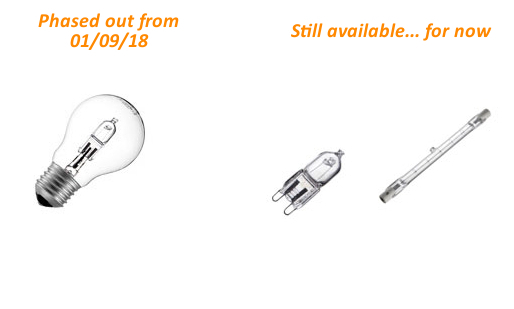From 1st September 2018 certain incandescent lamps will no longer be available. But really, you shouldn't be wasting your money on horrible halogen energy-gobblers these days anyway....
EU member states have decided that the death knell will sound for certain Class D lamps from September 2018 because they're inefficient. I'm sure the likes of Jeremy Clarkson are seething at this type of perceived Euro-meddling, but personally I don't think they've gone far enough.
The lamps that are fizzling out for good will be the non-directional halogens such as the GLS form factor. Other formats such as R7s (floodlight) and the capsule form factors like G4 and G9 will continue to remain available for now, but their time will come.

There really is no excuse to still be wasting money on halogen lamps now that LED prices have plummeted and offer instant-on, (no warm-up time) with form factors, beam angles and light outputs that match those of traditional lamps.
Sure, if you have a dimmer and want a GLS dimmable LED lamp, you're still looking at the best part of a tenner for a branded make at the time of writing which is a lot more than a £1.99 Osram halogen GLS lamp, but it will last immeasurably longer and use a fraction of the power which will save pounds off your 'leccy bill in the long term. Prices will drop as the manufacturers gear up to the new world and fight for shelf space on the high street.
Here's a common example; let's say you have eight GU10 downlights in your kitchen. If you're using 50W halogen lamps, that's 400 Watts you're burning. If you pay 15p/kWh for your electricity then that adds up to 6p/hour. By switching to modern branded 5W LED lamps you can have the same brightness and quality of light for a total of just 40 Watts and with a running cost of just over half a pence per hour.
Scale that up to an average of three hours per day, and over the course of a year those halogens would put £65.70 onto your electricity bill. If replaced with LED, it's only £6.57 - a saving of £59.13. Assuming you paid a fiver for each of those LED lamps (£40 total), they've paid for themselves within year one and put nearly twenty quid back into your pocket.
Also consider that quality branded LED lamps should last for years without requiring replacement unlike their short-lived halogen counterparts. Where you see LED lamps boasting a 15 or 20 year life, that's usually based on three hours of operation per day.
Switching from halogen to LED is a no-brainer; it's a better return for your money than putting it into a bank savings account. In the above example, assuming electricity prices remain constant, a £40 investment gives you a saving of £20 in year one, £60 in year two, £60 in year three..... and so on right up to as high as year 15-20!
For those thinking of stocking up on the doomed halogens, I'd say don't bother. LED alternatives will continue to improve and drop in price, so even if you're not convinced about LED technology now, it'll be a different story by September 2018.
If you've had enough of climbing the step ladder to replace blown halogen lamps and want assistance with converting to the right kind of LED lamp, contact me and we can tailor something to suit you specifically. When I put in LED lamps, I put my usual 24 month no-quibble warranty on them, so that's at least two years where you don't have to worry about changing light bulbs as any lamp failure will be changed by me for free!
Nobody should be mourning the loss of traditional incandescent lamps when the time comes. These filament burning lamps also burn a hole in your pocket. Good riddance to 'em!

